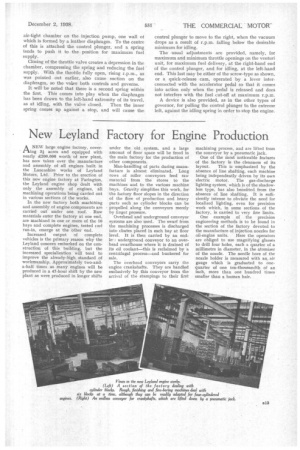New Leyland Factory for Engine Production
Page 49

If you've noticed an error in this article please click here to report it so we can fix it.
A NEW large engine factory, covert-ling 3i acres and equipped with nearly £200,000 worth of new plant, has now taken over the manufacture and assembly of all engines built in the Lancashire works of Leyland Motors, Ltd. Prior to the erection of this new engine factory at Farington, the Leyland engine shop dealt with only the assembly of engines, all machining operations being carried out in various sections of the works.
In the new factory both machining and assembly of engine components are carried out under one roof. Raw materials enter the factory at one end, are machined in one or more of the 10 bays and complete engines, tested End run-in, emerge at the other end.
Increased output of complete vehicles is the primary reason why the Leyland concern embarked on the construction of this building, but the increased specialization will tend to improve the already-high standard of workmanship. Approximately two-anda-half times as many engines will be produced in a 47-hour shift by the new plant as were produced in longer shifts under the old system, and a large amount of floor space will be freed in the main factory for the production of other components.
Man-handling of parts during manufacture is almost eliminated. Long rows of roller conveyors feed raw material from the stores to the machines and to the various machine bays. Gravity simplifies this work, for the factory floor slopes in the direction of the flow of production and heavy parts such as cylinder blocks can be propelled along the conveyors merely by finger pressure.
Overhead and underground conveyor systems are also used. The swarf from the machining processes is discharged into chutes placed in each bay at floor level. It is then carried by an end1e c: underground conveyor to an overhead swarfhouse where it is drained of its oil coolant—this is reclaimed by a centrifugal process—and bunkered for sale.
The overhead conveyors carry the engine crankshafts. They are handled exclusively by this conveyor from the arrival of the stampings to their first
machining process, and are lifted from the conveyor by a pneumatic jack. One of the most noticeable features of the factory is the cleanness of its
layout. This is emphasized by the absence of line shafting, each machine being independently driven by its own electric motor. The gas-discharge lighting system, which is of the shadowless type, has also benefited from the absence of line shafting. It is sufficiently intense to obviate the need for localized lighting, even for precision work which, in some sections of the factory, is carried to very fine limits.
One example of the precision engineering methods is to be found in the section of the factory devoted to the manufacture of injection nozzles for oil-engine units. Here the operators are obliged to use magnifying glasses • to drill four boles, each a quarter of a millimetre in diameter, in the atomizer of the nozzle. The needle bore of the nozzle holder is measured with an, air gauge which is graduated to onequarter of one ten-thousandth of an inch, more than one hundred times smaller than a human hair.




























































































